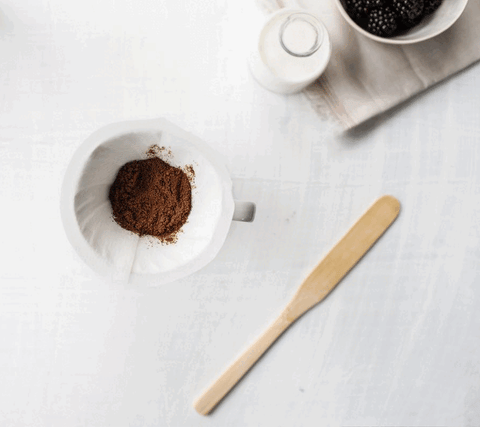If you’ve ever done a bit of reading up on ‘best brewing methods’ or new coffee brewing ‘how to’ recipes, there’s one word that might have surfaced itself - blooming. But what the blooming heck is a “coffee bloom” and why does it matter?
Turns out, it’s quite important in getting the best flavours from your coffee.
The science of the coffee bloom
There’s one thing that we know for certain; the coffee roasting process absolutely transforms an otherwise tasteless green coffee bean into something utterly delicious through a series of chemical and physical changes. One of the byproducts of the roasting process is carbon dioxide, or CO2.
So, to put it simply, the coffee bloom is the process of releasing stored gases from your roasted coffee, the first step in a brewing process. While the CO2 ‘degassing’ process starts to occur as soon as roasting has finished and even continues whilst packaged (ever notice that little ‘degassing valve’ on your bags of beans or grounds?) connoisseurs will tell you that blooming is an integral step to getting the maximum flavour from your coffee.
CO2 & keeping coffee fresh
Before we get to the ‘how to’, it’s important to note that CO2 plays an integral role in protecting the freshness and quality of roasted coffee. It protects coffee from going stale by enhancing its storage & shelf life, and keeps coffee from tasting ‘flat’ by keeping flavours and taste profiles vibrant.
The amount of time a coffee has been roasted will directly impact the amount of CO2 there is in the final result. As dark roasted coffee has been roasted to the ‘second crack’ (a build up of gases that actually ‘cracks’ the beans open), more gas has been released during the actual roasting process, and therefore the lighter the roast, the more CO2 that will still be in the beans.
As a general rule of thumb, the fresher the roast, the more CO2 that will be trapped inside the coffee beans or grounds.
So, how do you bloom your coffee?
They say that good things take time. And when it comes to taking that little bit of extra time to bloom your coffee before brewing, that statement couldn’t be more right. While CO2 is clearly important to protecting your coffee's flavour and shelf life, it can sometimes have an unpleasant or sour taste when consumed. The good news? It’s a very simple fix.

If you’re drinking any form of pour over coffee, like a Chemex or a V60, or even a cafetiere, it will benefit the most from blooming. To do so, you simply just need to saturate the grounds in the filter before you pour in more water. You should try to evenly dampen the grounds - that’ll help to avoid any actual coffee brewing. You’ll want to give it anywhere from 40-60 seconds to bubble and fully ‘breathe’ before continuing with the brewing process.
As for more immersive brewing methods, like an espresso machine or percolator, (capsule machines fall into this category too!) the coffee won’t benefit quite as much as it would in a pour over method. Because the extraction is short in comparison to a pour over method, the CO2 can actually help to create a richer crema. If you’ve got an automatic filter or high end capsule machine, there might be a ‘pre-infusion’ or ‘blooming’ setting that automatically does this for you.
The bottom line is, blooming your coffee will only enhance your coffee, and will never be a negative. So if you’ve got the extra minute in your morning to bloom before you brew, it’s something we highly recommend.


